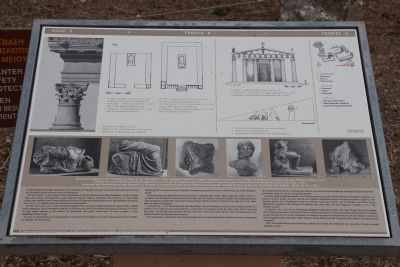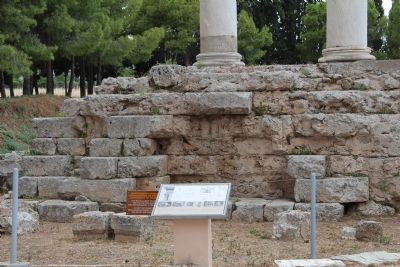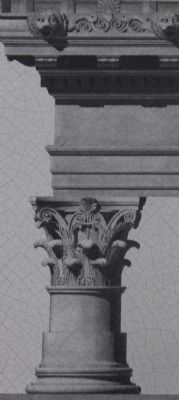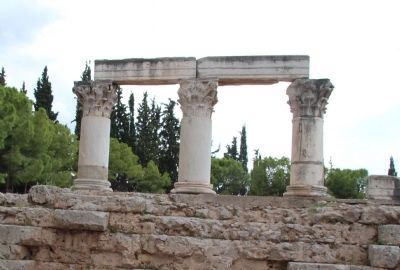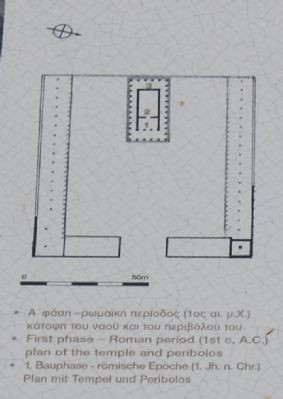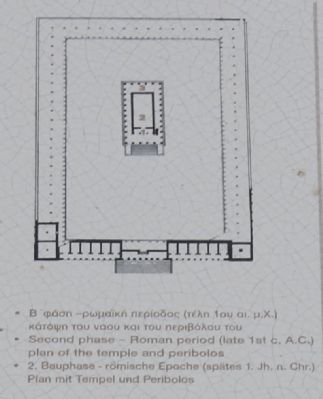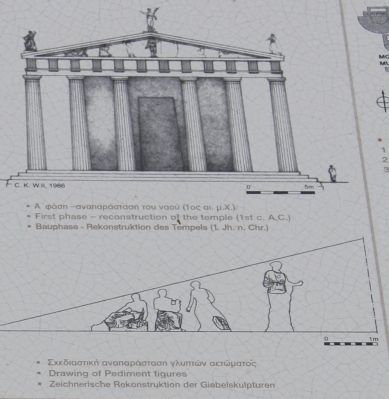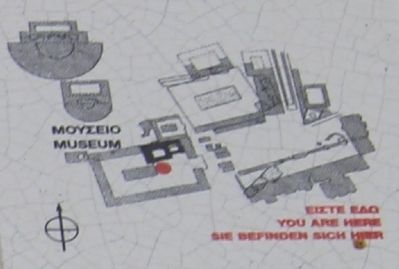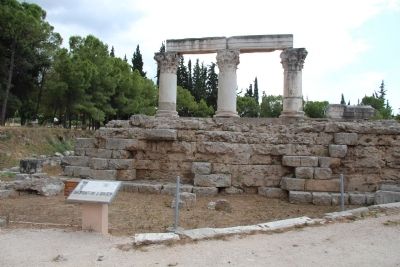Archea Korinthos in Korinthos, Peloponnese, Western Greece and the Ionian, Greece — Ελλάδα (Southeastern Europe, Balkan Peninsula)
Temple E
Standing 9.00 meters above the Forum, Temple E occupied as prominent a place in the Roman city as the Temple of Apollo.
In its first phase, the temple had stone foundations, probably with a triple crepis measuring 44.00 x 23.50 meters, on which was constructed a limestone Doric temple with six columns across its facade. The temple enclosure was bounded by a wall to the west and by stoas on the north and south. It is dated to the early 1st century A.D., soon after the death of Augustus.
In the late 1st century A.D. the temple was radically altered. The new building was built in the Corinthian order on a podium 3.4 meters high and was surrounded by a colonnade of 6 columns across the short sides and 12 along the long sides. The temple had a pronaos with two columns in antis and a long, narrow cella. The temple was completely enclosed by stoas during this phase.
From Pausanias's description, his temple appears to have been dedicated to Octavia, the sister of Augustus.
Erected by LZ Ephoreia of Prehistoric & Classical Antiquities.
Topics. This historical marker is listed in this topic list: Notable Places.
Location. 37° 54.293′ N, 22° 52.69′ E. Marker is in Archea Korinthos, Peloponnese, Western Greece and the Ionian, in Korinthos. Marker can be reached from Enotiki Archeas Korinthou north of EO Korinthou Argous (Local Route 7), on the left when traveling north. This marker is located in the Archaeological Park of Ancient Corinth, and is situated almost directly behind the archaeological park visitor center and museum, in front of the remains of the temple. Touch for map. Marker is in this post office area: Archea Korinthos, Peloponnese, Western Greece and the Ionian 200 07, Greece. Touch for directions.
Other nearby markers. At least 8 other markers are within walking distance of this marker. Road Network (about 90 meters away, measured in a direct line); Ancient Corinth (about 90 meters away); Glauke Fountain (about 90 meters away); Buildings at the West End of Roman Agora (about 90 meters away); Temple of Apollo (about 120 meters away); Archaeological Site of Ancient Corinth (about 180 meters away); The Rostra (Bema) of the Roman Forum (about 180 meters away); The Heroon at the Crossroads: an early sanctuary of Ancient Corinth (about 180 meters away). Touch for a list and map of all markers in Archea Korinthos.
More about this marker. With regards to the location of all of the markers in the Archaeological Park of Ancient Corinth, when going online and researching directional information, I could not locate any websites, or any online maps, that provided the names of the local streets, so it was difficult for me to provide
accurate and detailed directional information. The street and crossroad that I have provided are the closest two "named" streets that I could locate on any of the maps that I used.
One online site provided the following directions for getting to the archaeological park: "By car: 90 minutes from Athens. The exit to Ancient Corinth, approaching from the north, is about 2 kilometers west of the Tripolis interchange. Warning: visitors familiar with the village before 1996 should take the Patras interchange not the new Tripolis highway to arrive from the other side of the village; no exit was constructed and a U-turn cannot be made for ten kilometers."
Related markers. Click here for a list of markers that are related to this marker. To better understand the relationship, study each marker in the order shown.
Credits. This page was last revised on March 22, 2022. It was originally submitted on July 5, 2015, by Dale K. Benington of Toledo, Ohio. This page has been viewed 379 times since then and 20 times this year. Photos: 1, 2, 3, 4, 5, 6, 7, 8, 9. submitted on July 5, 2015, by Dale K. Benington of Toledo, Ohio.
